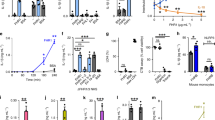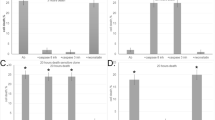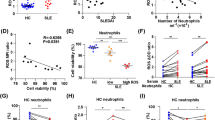Abstract
The Fas ligand (FasL), a member of the tumor necrosis factor family, induces apoptosis in Fas–bearing cells. The membrane–bound human FasL was found to be converted to a soluble form (sFasL) by the action of a matrix metalloproteinase–like enzyme. Two neutralizing monoclonal anti–human FasL antibodies were identified, and an enzyme–linked immunosorbent assay (ELISA) for sFasL in human sera was established. Sera from healthy persons did not contain a detectable level of sFasL, whereas those from patients with large granular lymphocytic (LCL) leukemia and natural killer (NK) cell lymphoma did. These malignant cells constitutively expressed FasL, whereas peripheral NK cells from healthy persons expressed FasL only on activation. These results suggested that the systemic tissue damage seen in most patients with LGL leukemia and NK–type lymphoma is due to sFasL produced by these malignant cells. Neutralizing anti–FasL antibodies or matrix metalloproteinase inhibitors may be of use in modulating such tissue damage.
This is a preview of subscription content, access via your institution
Access options
Subscribe to this journal
Receive 12 print issues and online access
$209.00 per year
only $17.42 per issue
Buy this article
- Purchase on Springer Link
- Instant access to full article PDF
Prices may be subject to local taxes which are calculated during checkout
Similar content being viewed by others
References
Gruss, H.-J. & Dower, S. Tumor necrosis factor ligand superfamily: Involvement in the pathology of malignant lymphoma. Blood 85, 3378–3404 (1995).
Nagata, S. & Golstein, P. The Fas death factor. Science 267, 1449–1456 (1995).
Suda, T., Takahashi, T., Golstein, P. & Nagata, S. Molecular cloning and expression of the Fas ligand: A novel member of the tumor necrosis factor family. Cell 75, 1169–1178 (1993).
Smith, C.A., Farrah, T. & Goodwin, R.G. The TNF receptor superfamily of cellular and viral proteins: Activation, costimulation, and death. Cell 76, 959–962 (1994).
Suda, T. et al. Expression of the Fas ligand in T-cell-lineage. J. Immunol. 154, 3806–3813 (1995).
Vignaux, F. et al. TCR/CD3 coupling to Fas-based cytotoxicity. J. Exp. Med. 181, 781–786 (1995).
Watanabe-Fukunaga, R. et al. The cDNA structure, expression, and chromosomal assignment of the mouse Fas antigen. J. Immunol. 148, 1274–1279 (1992).
Adachi, M. et al. Targeted mutation in the Fas gene causes hyperplasia in the peripheral lymphoid organs and liver. Nature Genet. 11, 294–300 (1995).
Adachi, M. et al. Enhanced and accelerated lymphoproliferation in Fas-null mice. Proc. Natl. Acad. Sci. USA (in the press).
Nagata, S. & Suda, T. Fas and Fas ligand: Ipr and gld mutations. Immunol. Today 16, 39–43 (1995).
Griffith, T., Brunner, T., Fletcher, S., Green, D. & Ferguson, T. Fas ligand-induced apoptosis as a mechanism of immune privilege. Science 270, 1189–1192 (1995).
Bellgrau, D. et al. A role for CD9S ligand in preventing graft rejection. Nature 377, 630–632 (1995).
Fisher, G.H. et al. Dominant interfering Fas gene mutations impair apoptosis in a human autoimmune lymphoproliferative syndrome. Cell 81, 935–946 (1995).
Rieux-Laucat, F. et al. Mutations in Fas associated with human lymphoproliferative syndrome and autoimmunity. Science 268, 1347–1349 (1995).
Takahashi, T. et al. Generalized lymphoproliferative disease in mice, caused by a point mutation in the Fas ligand. Cell 76, 969–976 (1994).
Watanabe-Fukunaga, R., Brannan, C.I., Copeland, N.G., Jenkins, N.A., Sc Nagata, S. Lymphoproliferation disorder in mice explained by defects in Fas antigen that mediates apoptosis. Nature 356, 314–317 (1992).
Hiramatsu, N. et al. Immunohistochemical detection of Fas antigen in liver tissue of patients with chronic hepatitis C. Hepatology 19, 1354–1359 (1994).
Debatin, K.-M. et al. High expression of APO-1 (CD95) on T lymphocytes from human immunodeficiency virus-1-infected children. Blood 83, 3101–3103 (1994).
Katsikis, P., Wunderlich, E., Smith, C., Herzenberg, L. & Herzenberg, L. Fas antigen stimulation induces marked apoptosis of T lymphocytes in human immunodeficiency virus-infected individuals. J. Exp. Med. 181, 2029–2036 (1995).
Falk, M.H. et al. Expression of the APO-1 antigen in Burkitt lymphoma cell lines correlates with a shift towards a lymphoblastoid phenotype. Blood 79, 3300–3306 (1992).
Ogasawara, J. et al. Lethal effect of the anti-Fas antibody in mice. Nature 364, 806–809 (1993).
Fiers, W. Tumor necrosis factor: Characterization at the molecular, cellular and in vivo level. FEBS Lett. 285, 199–212 (1991).
Vassalli, P. The pathophysiology of tumor necrosis factors. Annu. Rev. Immunol. 10, 411–452 (1992).
Mohler, K.M. et al. Protection against a lethal dose of endotoxin by an inhibitor of tumor necrosis factor processing. Nature 370, 218–220 (1994).
McGeehan, G.M. et al. Regulation of tumor necrosis factor-a processing by a metal-loproteinase inhibitor. Nature 370, 558–561 (1994).
Gearing, A.J.H. et al. Processing of tumor necrosis factor-a precursor by metallopro-teinases. Nature 370, 555–557 (1994).
Beutler, B. & Cerami, A. Cachectin and tumor necrosis factor as two sides of the same biological coin. Nature 320, 584–588 (1986).
Tanaka, M., Suda, T., Takahashi, T. & Nagata, S. Expression of the functional soluble form of human Fas ligand in activated lymphocytes. EMBO J. 14, 1129–1135 (1995).
Loughran, T.P., Clonal diseases of large granular lymphocytes. Blood 82, 1–14 (1993).
Takahashi, T. et al. Human Fas ligand: Gene structure, chromosomal location and species specificity. Int. Immunol. 6, 1567–1574 (1994).
Suda, T. & Nagata, S. Purification and characterization of the Fas ligand that induces apoptosis. J. Exp. Med. 179, 873–878 (1994).
Tagawa, S. et al. Transformation of large granular lymphocytic leukemia during the course of a reactive human herpesvirus-6 infection. Leukemia 6, 465–469 (1992).
Tagawa, S., Hatakeyama, M., Shibano, M., Taniguchi, T. & Kitani, T. The expression of the p75 subunit of interleukin 2 receptor in Tac negative leukemic cells of two patients with large granular lymphocytic leukemia. Blood 71, 1161–1164 (1988).
Kagi, D. et al. Fas and perform pathway as major mechanisms of T cell-mediated cvtotoxicity. Science 265, 528–530 (1994).
Kojima, H. et al. Two distinct pathways of specific killing revealed by perforin mutant cytotoxic T lymphocytes. Immunity 1, 357–364 (1994).
Lowin, B., Hahne, M., Mattmann, C. & Tschopp, J., T-cell cytotoxicity is mediated through perforin and Fas lytic pathways. Nature 370, 650–652 (1994).
Kataoka, T. et al. Acidification is essential for maintaining the structure and function of lytic granules of CTL. J. Immunol. 153, 3938–3947 (1994).
Chehimi, J. et al. Natural killer (NK) cell stimulatory factor increases the cytotoxic activity of NK cells from both healthy donors and human immunodeficiency virus-infected patients. J. Exp. Med. 175, 789–796 (1992).
Iwai, K. et al. Differential expression of bcl-2 and susceptibility to anti-Fas-mediated cell death in peripheral blood lymphocytes, monocytes, and neutrophils. Blood 84, 1201–1208 (1994).
Kagi, D. et al. Cytotoxicity mediated by T cells and natural killer cells is greatly impaired in perforin-deficient mice. Nature 369, 31–37 (1994).
Arase, H., Arase, N. & Saito, T. Fas-mediated cytotoxicity by freshly isolated natural killer cells. J. Exp. Med. 181, 1235–1238 (1995).
Leithauser, F. et al. Constitutive and induced expression of APO-1, a new member of the nerve growth factor/tumor necrosis factor receptor superfamily, in normal and neoplastic cells. Lab. Invest. 69, 415–429 (1993).
Owen-Schaub, L.B., Meterissian, S. & Ford, R.J. Fas/APO-1 expression and function on malignant cells of hematologic and nonhematologic origin. J. Immunother. 14, 234–241 (1993).
Gumperz, J.E. & Parham, P. The enigma of the natural killer cell. Nature 378, 245–248 (1995).
Yokoyama, W. Natural killer cell receptors specific for major rustocompatibility complex class I molecule. Proc. Natl. Acad. Sci. USA 92, 3081–3085 (1995).
Ameisen, J., Estaquier, J., Idziorek, T. & De Bels, F. Programmed cell death and AIDS: Significance, perspective and unanswered questions. Cell Death Differ. 2, 9–22 (1995).
Gougeon, M. Does apoptosis contribute to CD4 T cell depletion in human immunodeficiency virus infection? Cell Death Differ. 2, 1–8 (1995).
Enari, M., Hug, H. & Nagata, S. Involvement of an ICE-like protease in Fas-mediated apoptosis. Nature 375, 78–81 (1995).
Clare, J.J. et al. Production of mouse epidermal growth factor in yeast: High-level secretion using Pichia pastoris strains containing multiple gene copies. Gene 105, 205–212 (1991).
Mizushima, S. & Nagata, S. pEF-BOS: A powerful mammalian expression vector. Nucleic Acids Res. 18, 5322 (1990).
Author information
Authors and Affiliations
Rights and permissions
About this article
Cite this article
Tanaka, M., Suda, T., Haze, K. et al. Fas ligand in human serum. Nat Med 2, 317–322 (1996). https://doi.org/10.1038/nm0396-317
Received:
Accepted:
Issue Date:
DOI: https://doi.org/10.1038/nm0396-317
This article is cited by
-
Endogenous control of inflammation characterizes pregnant women with asymptomatic or paucisymptomatic SARS-CoV-2 infection
Nature Communications (2021)
-
Apoptotic functions of microRNAs in pathogenesis, diagnosis, and treatment of endometriosis
Cell & Bioscience (2020)
-
The role of CD95 and CD95 ligand in cancer
Cell Death & Differentiation (2015)
-
Proapoptotic CD95L levels in normal human serum and sera of breast cancer patients
Tumor Biology (2015)
-
Circulating levels of soluble Fas ligand reflect disease progression in multiple myeloma
Medical Oncology (2014)



